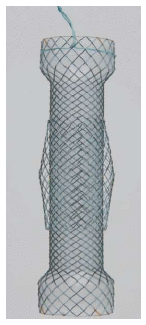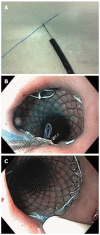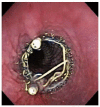Endoscopic management and prevention of migrated esophageal stents
- PMID: 24567792
- PMCID: PMC3930890
- DOI: 10.4253/wjge.v6.i2.49
Endoscopic management and prevention of migrated esophageal stents
Abstract
The use of self-expandable metallic stents has increased recently to palliate inoperable esophageal neoplasia and also in the management of benign strictures. Migration is one of the most common complications after stent placement and the endoscopist should be able to recognize and manage this situation. Several techniques for managing migrated stents have been described, as well as new techniques for preventing stent migration. Most stents have a "lasso" at the upper flange which facilitates stent repositioning or removal. An overtube, endoloop and large polypectomy snare may be useful for the retrieval of stents migrated into the stomach. External fixation of the stent with Shim's technique is efficient in preventing stent migration. Suturing the stent to the esophageal wall, new stent designs with larger flanges and double-layered stents are promising techniques to prevent stent migration but they warrant validation in a larger cohort of patients.
Keywords: Benign strictures; Complications; Endoscopy; Esophageal cancer; Stents.
Figures




References
-
- Repici A, Vleggaar FP, Hassan C, van Boeckel PG, Romeo F, Pagano N, Malesci A, Siersema PD. Efficacy and safety of biodegradable stents for refractory benign esophageal strictures: the BEST (Biodegradable Esophageal Stent) study. Gastrointest Endosc. 2010;72:927–934. - PubMed
-
- van Boeckel PG, Vleggaar FP, Siersema PD. A comparison of temporary self-expanding plastic and biodegradable stents for refractory benign esophageal strictures. Clin Gastroenterol Hepatol. 2011;9:653–659. - PubMed
-
- van Boeckel PG, Dua KS, Weusten BL, Schmits RJ, Surapaneni N, Timmer R, Vleggaar FP, Siersema PD. Fully covered self-expandable metal stents (SEMS), partially covered SEMS and self-expandable plastic stents for the treatment of benign esophageal ruptures and anastomotic leaks. BMC Gastroenterol. 2012;12:19. - PMC - PubMed
-
- Canena JM, Liberato MJ, Rio-Tinto RA, Pinto-Marques PM, Romão CM, Coutinho AV, Neves BA, Santos-Silva MF. A comparison of the temporary placement of 3 different self-expanding stents for the treatment of refractory benign esophageal strictures: a prospective multicentre study. BMC Gastroenterol. 2012;12:70. - PMC - PubMed
-
- Vleggaar FP, Siersema PD. Expandable stents for malignant esophageal disease. Gastrointest Endosc Clin N Am. 2011;21:377–88, vii. - PubMed
Publication types
LinkOut - more resources
Full Text Sources
Other Literature Sources

